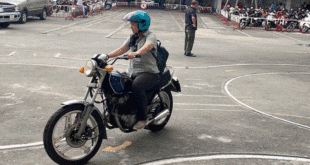
Hơn 6 triệu vụ tai nạn xe hơi ở Mỹ sẽ không xảy ra nếu người lái xe có kiến thức nhiều hơn về kỷ tuật lái xe an toàn! Bạn có biết những tay lái xe chuyên nghiệp và nhiều kinh nghiệm thường có những kỷ thuật riêng để bảo vệ an toàn của mình ngay cả khi tham gia giao thông và ở trên đường đua. Bài viết sau đây sẽ cung cấp cho bạn một số kỷ thuật lái xe “đỉnh cao” từ các chuyên gia từ đó bạn có thể áp dụng để bảo đảm an toàn cho bản thân củng như gia đình trong mọi chuyến đi.
Những Kỷ Thuật Lái Xe Có Thể Cứu Lây Mạng Sống Của Bạn
1/ Theo các chuyên gia về lái xe an toàn thì có 4 cấp độ về kỷ năng lái xe:
+ Cấp độ 1: Người mới biết lái xe
Một người biết lái xe chủ yếu tập trung vào việc học tập kỷ năng lái xe cơ bản và các quy tắc giao thông trên đường. Họ ít tiếp xúc với thực tế nên có xu hướng phản ứng chậm và không biết khoảng cách phân an toàn.
+ Cấp độ 2: Người lái xe thuần thục
Họ là những người đã có kinh nghiệm hiao thông trên đường. Họ lái xe tốt hơn và không loay hoay với những thao tác xử lý thông thường. Tuy nhiên họ vẫn chưa có nhiều kinh nghiệm và kỹ thuật lái xe tốt.
+ Cấp độ 3: Người lái xe có kinh nghiệm
Những bác tài có kinh nghiệm có thể điều khiển xe một cách dễ dàng và đôi khi có thể chủ động phạm luật. Mặc dù những người này có khả năng lái xe và dự đoán tình huống tốt nhưng điều đó không đồng nghĩa họ là một người lái xe an toàn. Lái xe an toàn là sự kết hợp của kỷ năng, kinh nghiệm và cả thái độ khi lái xe
+ Cấp độ 4: Những tay lái chuyên nghiệp
Lái xe trở thành hoạt động tự nhiên của những tay lái chuyên nghiệp. Họ hoàn toàn hiểu được chiếc xe của mình cà tất cả các quy tắc cần thiết khi lái xe. Những người này sử dụng kỷ thuật tốt nhất để dự đoàn tình huống hoặc tránh tai nạn xảy ra. Họ kiểm soát hoàn toàn chiếc xe và môi trường xung quanh và mọi lúc.
2/ Để Lái Xe An Toàn Thì Bạn Cần Phải Lưu Ý Những Điều Quan Trọn Sau:
Một bác tài có sự chuẩn bị tốt.
Có thái độ đúng đắn và được đào tạo bài bản là một khởi đầu tốt, nhưng có rất nhiều điều đơn giản có thể giúp cứu sông bạn. Dưới đây là một số điều chỉnh nhỏ mà bạn có thể làm cả trước và trong khi lái xe để đảm bảo sự an toàn cho bản thân mình:
+ Cửa kính: Bạn luôn nên để cửa ở chế độ đóng hoàn toàn hoặc mở hoàn toàn. Nếu tai nạn xảy ra, một cái cửa kính đóng dỡ có thể gây thương tích nặng cho bạn.
+ Tay: Đặt tay bạn trên vô lăng ở vị trí 3 giờ và 9 giờ sẽ an toàn hơn vị trí 2 giờ và 10 giờ
+ Khóa cửa xe: Điều này không chỉ giúp bạn ngăn ngừa những vụ cướp xe mà còn bảo vệ bạn không bị văng ra khỏi xe khi gặp tai nạn cao hơn 10 lần so với khi không khóa cửa.
+ Cả 2 phần của dây đai an toàn phải được mang đúng cách: Sẽ cực kỳ mất an toàn nếu để dây đai ngực nằm dưới cánh tay bạn. Đồng thời, sợi đai hông phải được đặt đúng phần thắt lưng, không phải trên bụng. Một khi bạn đã đeo dây an toàn bạn có thể thay đổi vị trị ghế sao co phù hợp nhất với người lái.
+ Chỉ dùng chân phải: Bạn chỉ nên dùng chân phải để phanh. Phanh bằng chân trái khi bạn trong cơn hoảng loạn có thể dẫn đến việc nhấn nhầm chân ga và phanh cùng một lúc, càng làm cho xe khó dùng lại hơn.
+ Giảm độ sáng: Giảm độ sáng của đèn trên bộ đồng hồ xe hơi có thể giúp bạn tăng khả năng nhìn thấy những vật bên ngoài vào ban đêm. Tuy nhiên, không nên chỉnh độ sáng xuống quá thấp để bạn vẫn có thể nhìn thấy rot những chỉ số trên bộ đồng hồ của mình.
Dự đoàn và lập kế hoạch
Mộ phần quan trọng của việc lái xe là dự đoàn những gì có thể xảy ra, từ đó, bạn có thể được chuẩn bị khi gặp sự cố. Những tay lái chuyên nghiệp luôn luôn dự đoán những gì có thể xảy ra và họ chuẩn bị sẵn để tránh bất kỳ rắc rối tiềm năng nào.
Những tình huống có thể xảy ra trên đường:
+ Những người lai xe băng qua đường sẽ không dừng lại
+ Những người cao tuổi đi trước bạn thường phanh không có lý do
+ Một vụ tai nạ ở phía trước có thể làm bạn đi chậm lại ở phía sau
+ Nếu gặp những người lái xe rẽ sang hướng khác mà không bật đèn tín hiệu, người lái phía sau có thể bật đèn rẽ trong khi vẫn đi thẳng
*Tay đua Kyle Busch của NASCAR nói: “ Phản ứng nhanh nhạy và nhìn thẳng về phía trước để dự đoán điều gì sắp xảy ra sẽ giúp bạn lái xe an toàn hơn. Tôi luôn luôn tìm ra một cách giải quyết cho riêng mình trong mỗi tình huống. Nếu tôi đang chạy trên đường cao tốc và có 2 chiếc xe khác kè 2 bên thì tôi sẽ nhấn ga để vượt lên trước hoặc giảm tốc độ để thoát khỏi đó.”
3/ Các Kỹ thuật đánh vô lăng
Hiểu được kỹ thuật này sẽ giúp bạn đánh vô lăng an toàn hơn đồng thời bảo vệ cánh tay và bàn tay của bạn khi gặp sự cố túi khí bung ra. Sử dụng kỹ thuật này để tranh việc nghịch tay khi lái xe.
+ Kỹ thuật đánh vô lăng chéo tay khi rẽ phải:
- Bước 1: Dùng tay phải kéo vô lăng xuống
- Bước 2: Thả tay phải ra và dùng tay trái đẩy vô lăng lên
- Bước 3: Giơ cao tay phải cao lên để lấy vô lăng và tiếp tục kép xuống
- Bước 4: Lặp lại
+ Kỹ thuật Roadcraft
Roadcraft là một hệ thống được những tay lái chuyên nghiệp sử dụng để giúp đưa ra quyết định nhanh chóng khi tiếp cận một mối nguy hiểm trên đường. Hệ thống phân chia các hành động cần thiết một cách hợp lý để người lái có thể thực hiện đẽ dàng và không bị nhầm lẫn.
Vị trí: Vị trí lái xe tốt là vị trí chạy xe an toàn, tầm quan sát tốt và đúng làn đường
Tốc độ: Điều chỉnh tốc độ phù hợp khi gặp sự cố trên đường. Điều chỉnh phanh cà bướm ga để xe có thể dừng lại ở khoảng cách an toàn.
Vào Số: Nên để số ở vị trí thích hợp để có thể điều khiển xe hiệu quả vượt qua những tình huống nguy hiểm trong 1 số.
Tăng Tốc: Tăng tốc để thoát khỏi tình huống nguy hiểm một cách an toàn
4/ Điều khiển xe của bạn.
Hiểu được cách điều khiển xe là một điều cực kỳ quan trọng. Mỗi người lái nên biết cách làm thế nào để ngăn chặn việc mất kiểm soát và những gì họ phải làm nếu rơi vào tình trạng này.
5/ Các kỹ thuật lái xe chuyên nghiệp:
Tuyết và bùn lầy:
+ Phanh xe theo đường thẳng
+ Ôm cua với chân ga giữ đều
+ Tăng tốc khi dã vượt qua khúc cua
Khi chạy xe trên đoạn đường tuyết rơi, bùn lầy, bạn nên chạy xe gần mép đường nơi được rắt nhiều cát, đá để luôn kiểm soát xe tốt
Không nên chạy xe theo vết xe khác, việc này có thể làm giảm tốc độ bám đường và sức kéo động cơ.
Nếu lái xe theo đúng vệt bánh xe phía trước, bạn sẽ tạo ra nhiều băng hơn do tuyết bị nén lại và tan chảy ra.
Đối với đường trơn:
Mỗi chiếc xe sẽ phản ứng khác nhau trong điều kiện này, vì vậy hãy hiểu rỏ xe mà bạn đang lái
+ Lốp xe có bề ngang rộng sẽ dễ gặp hiện tượng Hydroplane ( mất lái và kiểm soát phanh kho có lớp nước ngăn cách sự tiếp xúc giữa bánh xe và mặt đường) khi đường ướt. Do đó, bạn hãy chủ động đánh lái, không nên dùng phanh trong trường hợp này.
+ Để xe ổn định trở lại, bạn cần chủ động đánh lái để xe quay về đúng vị trí an toàn, tuyệt đối không đạp ga hoặc đạp phanh trong lúc xe bị trượt, lúc xe đã cân bằng trở lại thì hãy đạp phanh hoặc ga một cách thích hợp, tùy trường hợp.
+ Khi bạn mất kiểm soát với chiếc xe số sàn, hãy nhớ “đạp mạnh cả 2 chân vào phanh ly hợp”. Điều này sẽ giúp bạn khóa chặt cả 4 bánh, tránh trường hợp máy bị kẹt và giúp chiếc xe dừng hẳn lại.
6/ Các kỹ thuật phanh
Có khá nhiều cách phanh hiệu quả, nhưng không hẳn bác tài nào củng nhận ra. Một vài mẫu xe có thể hổ trợ phanh khi xe mất kiểm soát, nhưng đa số còn lại thì không có. Vì vậy, hiểu rõ hệ thống phanh của xe mình kết hợp với kỹ thuật phanh hợp lý trong các tình huống khẩn cấp sẽ là yếu tố quyết định giữa sự sống và cái chết.
+ Phanh theo ngưỡng
+ Khóa bánh
+ Phanh ABS ( Hệ thống chống bó cứng phanh)
+ Phanh theo nhịp
Kỹ thuật phanh theo nhịp
Phanh theo nhịp là một kỹ thuật lái xe chuyên nghiệp nó cho phép chiếc xe có thể vùa phanh vừa đánh lái trên mặt đường trơn trượt, giúp người lái có thời gian tối đa để kiểm nguy hiểm phía trước.
- Bước 1: Đạp phanh cho đến khi các bánh bị hãm
- Bước 2: Giảm lực đạp phanh cho đến khi các bánh xe có thể bám đường và quay trở lại
- Bước 3: Đạp phanh mạnh lần 2, sau đó lại nhả bớt phanh để các bánh xe quay trở lại
- Bước 4: Lặp lại quá trình này cho đến khi xe dùng hẳn lại hoặc không còn ặp nguy hiểm
Nếu xe bạn có trang bị hệ thống chống bó cứng phanh ABS, quá trình phanh theo nhịp này sẽ được thực hiện hoàn toàn tự động
Kỹ thuật phanh theo ngưỡng
Phanh theo ngưỡng là một kỹ thuật dùng để đua xe, nhưng nó cũng có thể áp dụng trên đường phố. Lực phanh tối ưu được tạo ra khi bánh xe bắt đầu trượt, phanh xe sau thời điểm này sẽ làm cho bánh xe trượt đi và giảm hiện tượng “miết” bánh xe trên mặt đường. Nếu xe bạn có được độ trượt bánh tối ưu thì lực phanh cũng như hiện tượng “miết” bánh xe sẽ giảm đi đáng kể.
- Bước 1: Đạp phanh như bình thường
- Bước 2: Tăng lực đạp phanh từ từ cho đến khi bánh xe bị khóa
- Bước 3: Giảm lực đạp phanh một ít để bánh xe lấy lại sức kéo và không bị trượt.
Nếu xe bạn buộc phải chạy vòng qua một vụ va chạm phía trước với tốc độ cao, kỹ thuật này sẽ giúp người lái giảm tốc nhanh chống đồng thời vẫn kiểm soát được vô lăng.
7/ Thoát khỏi nguy cơ va chạm.
* Cảnh báo: Những kỹ thuật lái này chỉ nên sử dụng khi gặp nguy hiểm,, không được sử dụng để thoát khỏi sự truy đuổi của cảnh sát. Người lái cần phải luyện tập những kỹ năng này trước khi ứng dụng vào thực tế trên đường.
Dưới đây là những kỹ thuật giúp người lái có thể tránh khỏi 1 vụ tai nạn hoặc tránh làm cho 1 vụ tai nạn trở nên nghiêm trọng hơn. Những kỹ thuật lái này sẽ giúp các tài xế có thể tránh gặp tai nạn hoặc thoát khỏi 1 tình huống nguy hiểm phía trước một cách an toàn.
Hiểu rõ cách ôm cua chữ chi hoặc cua chữ chi đôi có thể giúp bạn đổ đèo một cách nhanh chóng để thoát một trận lở tuyết hay lở núi. Kỹ thuật ôm cua cũng có thể giúp bạn quay đầu xe một cách nhanh chóng để thoát khỏi nguy hiểm gặp trên đường.
Kỹ thuật ôm cua chữ chi ( Hairpin): Những khúc cua này thường xuất hiện trên đoạn đường đèo dốc. Một khúc cua chữ chi có thể cong đến 180 độ
- Bước 1: Phanh xe theo đường thẳng
- Bước 2: Nhả phanh trước khi rẻ
- Bước 3:Rẽ nhẹ nhàng tới góc nhọn ( trung tâm khúc cua)
- Bước 4: Tăng tốc để ra khỏi khúc cua càng nhanh càng tốt
Kỹ thuật ôm cua chữ chi đôi:
- Bước 1: Phanh theo đường thẳng
- Bước 2: Nhả phanh trước khi rẽ
- Bước 3: Rẽ từ từ đến góc nhọn
- Bước 4: Sau khi thoát khỏi cua đầu tiên, bạn nên từ từ cho xe lấn qua làn đối diện một tí. Nếu chạy nhanh quá có thể làm cho xe khó ôm cua thứ 2 hơn.
Kỹ thuật lái xe Bootleger: Người lái xe có thể chuyển hướng xe 180 độ giũa 2 làn xe mà không cần phải dừng lại.
- Bước 1: Nhanh chóng vào số thấp ( thườn là số 2)
- Bước 2: Rẽ nhanh vô lăng đế sang hướng làn đối diện
- Bước 3: Đạp phanh
- Bước 4: Xe đi vào làn đối diện và hoàn toàn chuyển hướng ngược lại
- Bước 5: Xe dừng lại hoàn toàn. Sau đó tăng ga và tiến về phía trước.
Kỹ thuật quay xe J-turn
- Bước 1: Lùi xe
- Bước 2: Tăng tốc 24 – 32 km/h
- Bước 3: Đặt tay lên vô lăng ở vị trí 2 giờ và 8 giờ
- Bước 4: Nhanh chóng nhả ga và quay vô lăng ( ít nhất ½ vòng)
- Bước 5: Đánh nhanh vô lăng về hướng ngược lại. Chiếc xe sẽ bắt đầu quay nhưng vẫn trong tầm kiểm soát.
Kỹ năng sử dụng Bootleger hay J-turn cho phép bạn thoát khỏi tình trạng khẩn cấp cự kỳ nhanh chóng.
Kết Luận
Tất cả những kỹ thuật lái xe chuyên nghiệp này nhằm giúp bạn trở thành một tay lái kinh nghiệm và sáng suốt hơn. Hy vọng lần sau, khi lái xe trên đường, bạn sẽ sử dụng những kỹ thuật lái xe an toàn này.
 Trường đào tạo & thi sát hạch lái xe tại TP Hồ Chí Minh Trường đào tạo, dạy học và thi sát hạch lái xe máy, xe oto ở Thành Phố Hồ Chí Minh
Trường đào tạo & thi sát hạch lái xe tại TP Hồ Chí Minh Trường đào tạo, dạy học và thi sát hạch lái xe máy, xe oto ở Thành Phố Hồ Chí Minh



